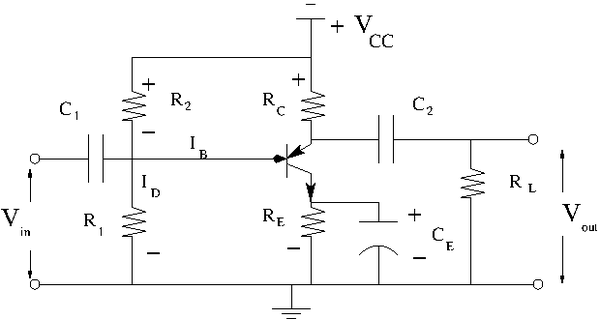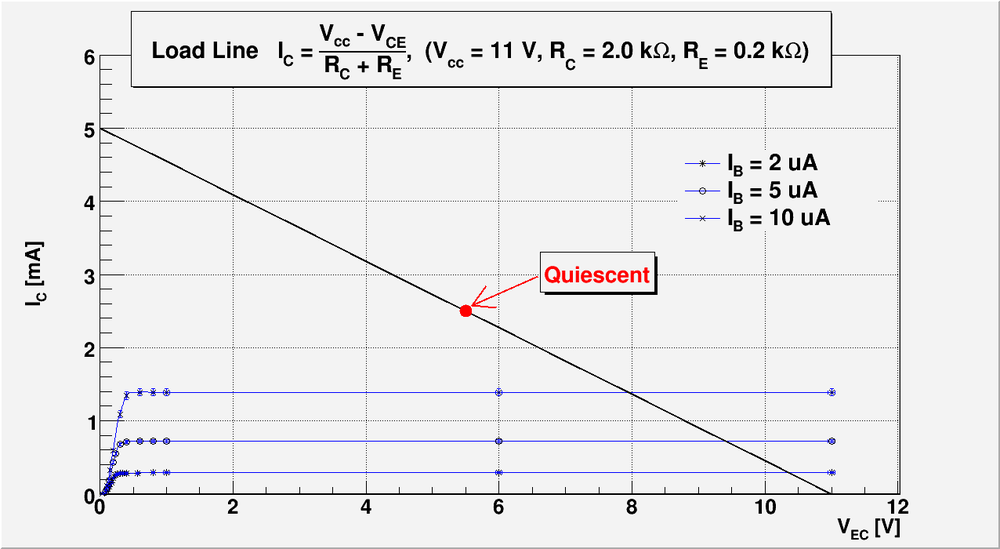Difference between revisions of "Lab 14 RS"
| Line 72: | Line 72: | ||
| − | And <math>R_2</math> we can find from Kirchhoff | + | And <math>R_2</math> we can find from Kirchhoff Voltage Low: |
<math>V_{CC} = I_2 \cdot R_2 + V_B</math>. | <math>V_{CC} = I_2 \cdot R_2 + V_B</math>. | ||
| − | + | and Kirchhoff Current Low: | |
<math>I_2 = I_1 + I_B</math> | <math>I_2 = I_1 + I_B</math> | ||
Revision as of 20:58, 21 March 2011
The Common Emitter Amplifier
Circuit
Construct the common emitter amplifier circuit below according to your type of emitter.
Calculate all the R and C values to use in the circuit such that
- a. Try and
- b. mA DC with no input signal
- c. V
- d. to prevent burnout
- e.
- f. mA
Let's , and .
The load line equation becomes:
Draw a load line using the -vs- from the previous lab 13. Record the value of or .
On the plot below I overlay the output transistor lines (from the previous lab report #13) and the Load Line calculated above.
My based on my previous lab report #13
Set a DC operating point so it will amplify the input pulse given to you. Some of you will have sinusoidal pulses others will have positive or negative only pulses.
I will set up my operating point in the middle of the load line:
, .
Let's calculate all bias voltage needed to set up this operating point. Because the knowing of and is very important for this calculation I did the preliminary set up to measure this quantities. They are the only parameters which depends from transistor. I was able to find:
Now
To set up the operating point above we need to set up .
We have:
.
To get operating point independent of the transistor base current we want
Let's
So
And we can find from Kirchhoff Voltage Low:
.
and Kirchhoff Current Low:
So
I tried to adjust my calculation by varying the fee parameters and to get good values for resistors I can easily to set up.
Measure all DC voltages in the circuit and compare with the predicted values.(10 pnts)
My predicted DC voltage are:
We have from operating point:
And because we have silicon transistor:
Now
My measured DC voltage are:
First note that my is close to predicted values .
Also note that my is a little higher than my initial operating point . The main reason is that my actual values of instead of as I was assumed initially. That will reduce my voltage that reduce my current. So I will shift to right my operating point from to lower values and correspondingly will increase my .
By direct measurements my operating point now is and
Let's check do my operating point is still on my load line. I have , . So from load line equation:
.
So my operating point lies in my load line within experimental error.
Measure the voltage gain as a function of frequency and compare to the theoretical value.(10 pnts)
Measure and at about 1 kHz and compare to the theoretical value.(10 pnts)
How do you do this? Add resistor in front of which you vary to determine and then do a similar thing for except the variable reistor goes from to ground.
Measure and as a function of frequency with removed.(10 pnts)
Questions
- Why does a flat load line produce a high voltage gain and a steep load line a high current gain? (10 pnts)
- What would be a good operating point an an common emitter amplifier used to amplify negative pulses?(10 pnts)
- What will the values of , , and be if the transistor burns out resulting in infinite resistance. Check with measurement.(10 pnts)
- What will the values of , , and be if the transistor burns out resulting in near ZERO resistance (ie short). Check with measurement.(10 pnts)
- Predict the change in the value of if is increased from 10 to 50 (10 pnts)
- Sketch the AC equivalent circuit of the common emitter amplifier.(10 pnts)
Go Back to All Lab Reports Forest_Electronic_Instrumentation_and_Measurement

